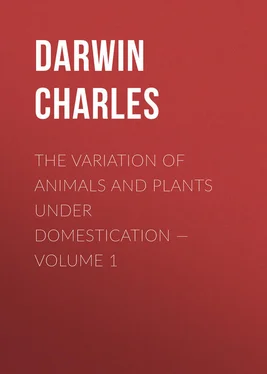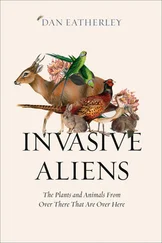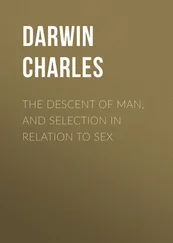Charles Darwin - The Variation of Animals and Plants under Domestication — Volume 1
Здесь есть возможность читать онлайн «Charles Darwin - The Variation of Animals and Plants under Domestication — Volume 1» — ознакомительный отрывок электронной книги совершенно бесплатно, а после прочтения отрывка купить полную версию. В некоторых случаях можно слушать аудио, скачать через торрент в формате fb2 и присутствует краткое содержание. Жанр: foreign_antique, foreign_prose, на английском языке. Описание произведения, (предисловие) а так же отзывы посетителей доступны на портале библиотеки ЛибКат.
- Название:The Variation of Animals and Plants under Domestication — Volume 1
- Автор:
- Жанр:
- Год:неизвестен
- ISBN:нет данных
- Рейтинг книги:5 / 5. Голосов: 1
-
Избранное:Добавить в избранное
- Отзывы:
-
Ваша оценка:
- 100
- 1
- 2
- 3
- 4
- 5
The Variation of Animals and Plants under Domestication — Volume 1: краткое содержание, описание и аннотация
Предлагаем к чтению аннотацию, описание, краткое содержание или предисловие (зависит от того, что написал сам автор книги «The Variation of Animals and Plants under Domestication — Volume 1»). Если вы не нашли необходимую информацию о книге — напишите в комментариях, мы постараемся отыскать её.
The Variation of Animals and Plants under Domestication — Volume 1 — читать онлайн ознакомительный отрывок
Ниже представлен текст книги, разбитый по страницам. Система сохранения места последней прочитанной страницы, позволяет с удобством читать онлайн бесплатно книгу «The Variation of Animals and Plants under Domestication — Volume 1», без необходимости каждый раз заново искать на чём Вы остановились. Поставьте закладку, и сможете в любой момент перейти на страницу, на которой закончили чтение.
Интервал:
Закладка:
A slight difference in climate or pasture sometimes slightly affects the fleece, as has been observed even in different districts in England, and is well shown by the great softness of the wool brought from Southern Australia. But it should be observed, as Youatt repeatedly insists, that the tendency to change may generally be counteracted by careful selection. M. Lasterye, after discussing this subject, sums up as follows: "The preservation of the Merino race in its utmost purity at the Cape of Good Hope, in the marshes of Holland, and under the rigorous climate of Sweden, furnishes an additional support of this my unalterable principle, that fine-woolled sheep may be kept wherever industrious men and intelligent breeders exist."
That methodical selection has effected great changes in several breeds of sheep no one who knows anything on the subject, entertains a doubt. The case of the Southdowns, as improved by Ellman, offers perhaps the most striking instance. Unconscious or occasional selection has likewise slowly produced a great effect, as we shall see in the chapters on Selection. That crossing has largely modified some breeds, no one who will study what has been written on this subject — for instance, Mr. Spooner's paper — will dispute; but to produce uniformity in a crossed breed, careful selection and "rigorous weeding," as this author expresses it, are indispensable. (3/95. 'Journal of R. Agricult. Soc. of England' volume 20 part 2, W.C. Spooner on cross-Breeding.)
In some few instances new breeds have suddenly originated; thus, in 1791, a ram-lamb was born in Massachusetts, having short crooked legs and a long back, like a turnspit-dog. From this one lamb the otter or ancon semi- monstrous breed was raised; as these sheep could not leap over the fences, it was thought that they would be valuable; but they have been supplanted by merinos, and thus exterminated. The sheep are remarkable from transmitting their character so truly that Colonel Humphreys (3/96. 'Philosoph. Transactions' London 1813 page 88.) never heard of "but one questionable case" of an ancon ram and ewe not producing ancon offspring. When they are crossed with other breeds the offspring, with rare exceptions, instead of being intermediate in character, perfectly resemble either parent; even one of twins has resembled one parent and the second the other. Lastly, "the ancons have been observed to keep together, separating themselves from the rest of the flock when put into enclosures with other sheep."
A more interesting case has been recorded in the Report of the Juries for the Great Exhibition (1851), namely, the production of a merino ram-lamb on the Mauchamp farm, in 1828, which was remarkable for its long, smooth, straight, and silky wool. By the year 1833 M. Graux had raised rams enough to serve his whole flock, and after a few more years he was able to sell stock of his new breed. So peculiar and valuable is the wool, that it sells at 25 per cent above the best merino wool: even the fleeces of half-bred animals are valuable, and are known in France as the "Mauchamp-merino." It is interesting, as showing how generally any marked deviation of structure is accompanied by other deviations, that the first ram and his immediate offspring were of small size, with large heads, long necks, narrow chests, and long flanks; but these blemishes were removed by judicious crosses and selection. The long smooth wool was also correlated with smooth horns; and as horns and hair are homologous structures, we can understand the meaning of this correlation. If the Mauchamp and ancon breeds had originated a century or two ago, we should have had no record of their birth; and many a naturalist would no doubt have insisted, especially in the case of the Mauchamp race, that they had each descended from, or been crossed with, some unknown aboriginal form.
GOATS.
From the recent researches of M. Brandt, most naturalists now believe that all our goats are descended from the Capra aegagrus of the mountains of Asia, possibly mingled with the allied Indian species C. falconeri of India. (3/97. Isidore Geoffroy St. Hilaire 'Hist. Nat. Generale' tome 3 page 87. Mr. Blyth 'Land and Water' 1867 page 37 has arrived at a similar conclusion, but he thinks that certain Eastern races may perhaps be in part descended from the Asiatic markhor.) In Switzerland, during the neolithic period, the domestic goat was commoner than the sheep; and this very ancient race differed in no respect from that now common in Switzerland. (3/98. Rutimeyer 'Pfahlbauten' s. 127.) At the present time, the many races found in several parts of the world differ greatly from each other; nevertheless, as far as they have been tried (3/99. Godron 'De l'Espece' tome 1 page 402.) they are all quite fertile when crossed. So numerous are the breeds, that Mr. G. Clark (3/100. 'Annals and Mag. of Nat History' 2nd series volume 2 1848 page 363.) has described eight distinct kinds imported into the one island of Mauritius. The ears of one kind were enormously developed, being, as measured by Mr. Clark, no less than 19 inches in length and 4 3/4 inches in breadth. As with cattle, the mammae of those breeds which are regularly milked become greatly developed; and, as Mr. Clark remarks, "it is not rare to see their teats touching the ground." The following cases are worth notice as presenting unusual points of variation. According to Godron (3/101. 'De l'Espece' tome 1 page 406. Mr. Clark also refers to differences in the shape of the mammae. Godron states that in the Nubian race the scrotum is divided into two lobes; and Mr. Clark gives a ludicrous proof of this fact, for he saw in the Mauritius a male goat of the Muscat breed purchased at a high price for a female in full milk. These differences in the scrotum are probably not due to descent from distinct species: for Mr. Clark states that this part varies much in form.), the mammae differ greatly in shape in different breeds, being elongated in the common goat, hemispherical in the Angora race, and bilobed and divergent in the goats of Syria and Nubia. According to this same author, the males of certain breeds have lost their usual offensive odour. In one of the Indian breeds the males and females have horns of widely-different shapes (3/102. Mr. Clark 'Annals and Mag. of Nat. Hist.' 2nd series volume 2 1848 page 361.); and in some breeds the females are destitute of horns. (3/103. Desmarest 'Encyclop. Method. Mammalogie' page 480.) M. Ramu of Nancy informs me that many of the goats there bear on the upper part of the throat a pair of hairy appendages, 70 mm. in length and about 10 mm. in diameter, which in external appearance resemble those above described on the jaws of pigs. The presence of inter-digital pits or glands on all four feet has been thought to characterise the genus Ovis, and their absence to be characteristic of the genus Capra; but Mr. Hodgson has found that they exist in the front feet of the majority of Himalayan goats. (3/104. 'Journal of Asiatic Soc. of Bengal' volume 16 1847 pages 1020, 1025.) Mr. Hodgson measured the intestines in two goats of the Dugu race, and he found that the proportional length of the great and small intestines differed considerably. In one of these goats the caecum was thirteen inches, and in the other no less than thirty-six inches in length!
CHAPTER 1.IV
DOMESTIC RABBITS.
DOMESTIC RABBITS DESCENDED FROM THE COMMON WILD RABBIT. ANCIENT DOMESTICATION. ANCIENT SELECTION. LARGE LOP-EARED RABBITS. VARIOUS BREEDS. FLUCTUATING CHARACTERS. ORIGIN OF THE HIMALAYAN BREED. CURIOUS CASE OF INHERITANCE. FERAL RABBITS IN JAMAICA AND THE FALKLAND ISLANDS. PORTO SANTO FERAL RABBITS. OSTEOLOGICAL CHARACTERS. SKULL. SKULL OF HALF-LOP RABBITS. VARIATIONS IN THE SKULL ANALOGOUS TO DIFFERENCES IN DIFFERENT SPECIES OF HARES. VERTEBRAE. STERNUM. SCAPULA. EFFECTS OF USE AND DISUSE ON THE PROPORTIONS OF THE LIMBS AND BODY. CAPACITY OF THE SKULL AND REDUCED SIZE OF THE BRAIN. SUMMARY ON THE MODIFICATIONS OF DOMESTICATED RABBITS.
Читать дальшеИнтервал:
Закладка:
Похожие книги на «The Variation of Animals and Plants under Domestication — Volume 1»
Представляем Вашему вниманию похожие книги на «The Variation of Animals and Plants under Domestication — Volume 1» списком для выбора. Мы отобрали схожую по названию и смыслу литературу в надежде предоставить читателям больше вариантов отыскать новые, интересные, ещё непрочитанные произведения.
Обсуждение, отзывы о книге «The Variation of Animals and Plants under Domestication — Volume 1» и просто собственные мнения читателей. Оставьте ваши комментарии, напишите, что Вы думаете о произведении, его смысле или главных героях. Укажите что конкретно понравилось, а что нет, и почему Вы так считаете.












